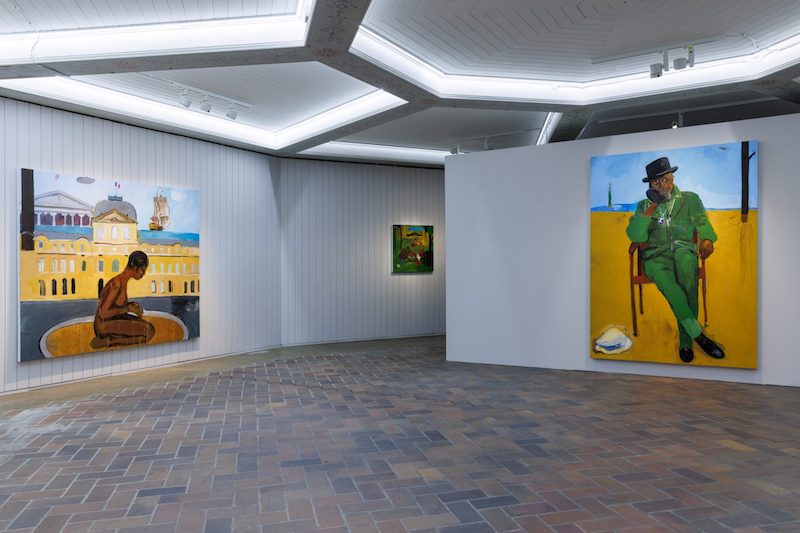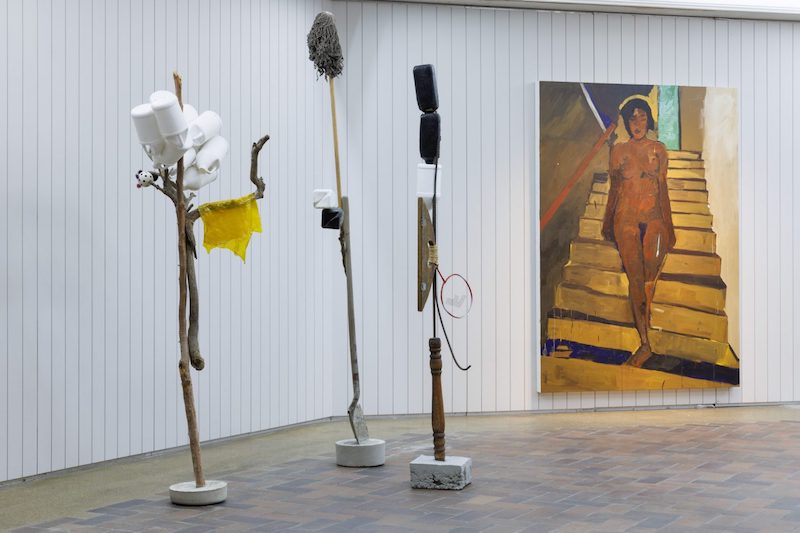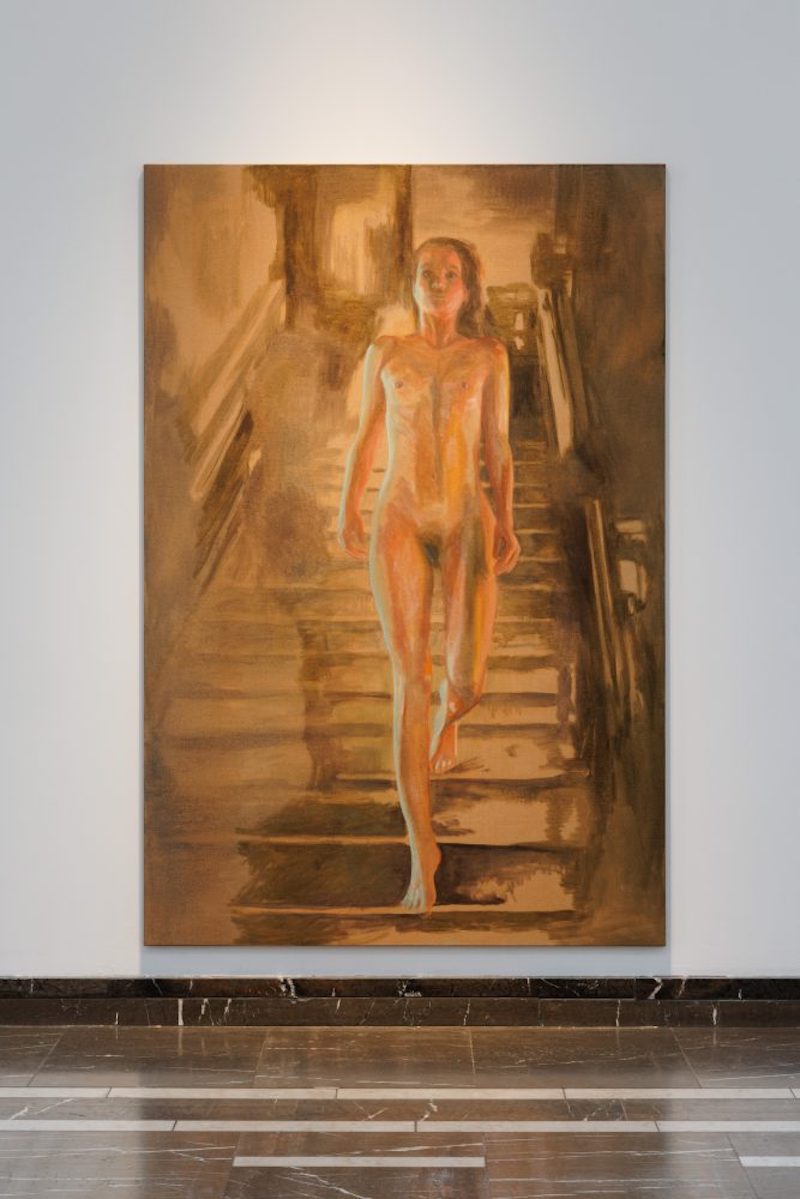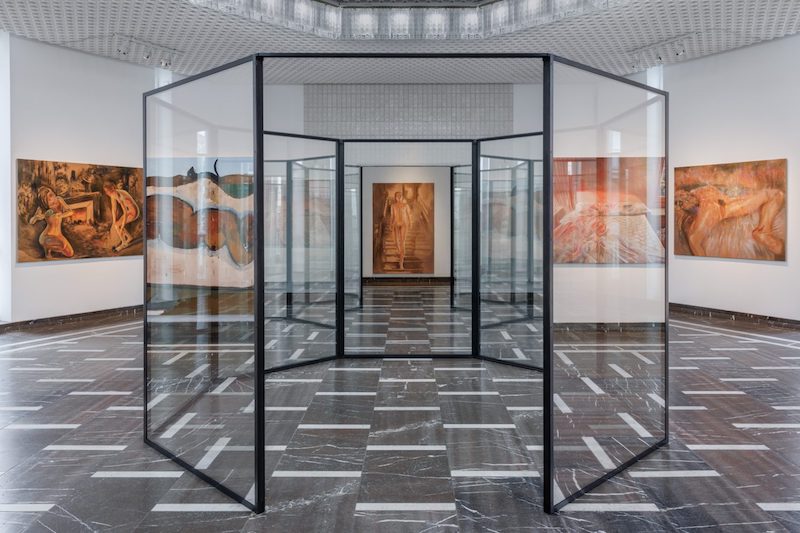by Ananyaa Sathyanarayana // May 16, 2024
How does art history influence contemporary artists today? ‘You Me,’ an exhibition featuring works by Jill Mulleady and Henry Taylor, now showing at Schinkel Pavillon, prompts this question most clearly through the artists’ rendition of Marcel Duchamp’s painting ‘Nu Descendant un Escalier’ (1937), a key aspect of the show. The curatorial decision to place the work as the first thing we encounter is significant, as it sets the scene for what follows. Directly behind Duchamp’s ‘Nu Descendant un Escalier’ is Henry Taylor’s version of the painting. On the second floor of the gallery, positioned right above Taylor’s version, is Jill Mulleady’s depiction of the painting, making it clear that we are meant to view these pieces in conversation with one another. Despite their long-standing friendship, Mulleady and Taylor’s painting styles are very different, with Mulleady’s smoother and more based in realism, while Taylor’s appears more structured and unembellished. The figures in Taylor’s pieces are often placed in very public environments, while Mulleady’s works are situated in private space, giving us a voyeuristic position from which to access her works.

Jill Mulleady & Henry Taylor: ‘You Me,’ 2024, installation view, Schinkel Pavillon // Courtesy the artist and Hauser & Wirth, photo by Frank Sperling 2024
Taylor’s version of ‘Nu Descendant un Escalier’ shows an Black woman, her eyes closed, walking down the stairs towards the viewer. His version brings forth a sense of movement, clearly paying tribute to Gerhard Richter’s ‘Ema (Akt auf einer Treppe)’ through the similar setting, lighting and expression of both women. The movement in the original piece by Duchamp as well as in ‘Ema’ is present in Taylor’s piece as well, albeit softer, making it seem like she is walking slowly, compared to Duchamp’s figure who is depicted in swift motion. What makes Taylor’s piece unique is his decision to depict a woman of color in his rendition of ‘Nu Descendant un Escalier,’ standing as a powerful affirmation of beauty and confidence. This choice highlights the artist’s critique of art historical tropes, especially in Duchamp’s time, and the importance of prominently including women of color in iconic works of art.

Jill Mulleady & Henry Taylor: ‘You Me,’ 2024, Schinkel Pavillon // Courtesy the artist, Defares Collection, Netherlands, Eva Presenhuber and Hauser & Wirth, photo by Frank Sperling, 2024
A striking aspect of Taylor’s version of the painting is the door the figure seems to emerge from, which is highlighted in a turquoise color, creating a stark contrast to the rest of the dull environment. Turquoise, a color that often symbolizes tranquility and protection, is subdued by the monotonous brown tones of the stairway. This bold choice invites speculation about the space beyond the door, as the color gives a sense of openness or expansiveness to the environment she is departing from.
Mulleady’s rendition of the painting, on the other hand, depicts a white woman who looks to be in shock, her eyes are wide open and she is caught mid-step, halting any sort of movement. Her body looks to be on alert and frigid, like she has seen something she wasn’t supposed to. Mulleady paints with a sense of sfumato, which at first gives the painting a more serene feeling, an impression that is ultimately overshadowed by the expression on the figure’s face. Portrayals of violence that women face reappear throughout Mulleady’s works, which occasionally include depictions of distressing scenes. These depictions speak to the darker aspects of human experience, reinforced by the choice to display Otto Dix’s ‘Lustmord’ and Käthe Kollwitz’s ‘Vergewaltigung’ alongside Mulleady’s paintings in the show.

Jill Mulleady: ‘Stairs / Nude Descending,’ 2024 // Courtesy the artist and Galerie Neu, photo by Frank Sperling, 2024
The effect of Mulleady’s ‘Stairs / Nude Descending’ is accentuated by the artist’s site-specific glass sculpture, which visitors can enter and walk through. When looking into the sculpture through its entrance, you can see yourself positioned below the figure in Mulleady’s painting. The work forces us to confront ourselves in relation to this figure, as well as enter the space the sculptural piece takes up. We might begin to wonder whether we are the catalyst for this shocked expression, leading to a consideration of what, in us, might be worthy of this reaction. The mirrored space, while in some ways claustrophobic, has the effect of creating multiple reflections, but Mulleady’s other paintings eventually bring us back to the space and limit this sense of infinity.

Jill Mulleady & Henry Taylor: ‘You Me,’ 2024, installation view, Schinkel Pavillon // Courtesy the artist, Gladstone Gallery, Galerie Neu, photo by Frank Sperling, 2024
‘You Me’ is meant to represent the connection between two artists from different generations and their long-standing friendship, as well as their adoration for painting. Intertwining the historical influence of art with contemporary perspectives, the visual conversation between the various works on show invites critical reflection on themes of identity and empowerment across art history.
Exhibition Info
Schinkel Pavillon
Jill Mulleady & Henry Taylor: ‘You Me’
Exhibition: Feb. 17–May 19, 2024
schinkelpavillon.de
Oberwallstraße 32, 10117 Berlin, click here for map



















